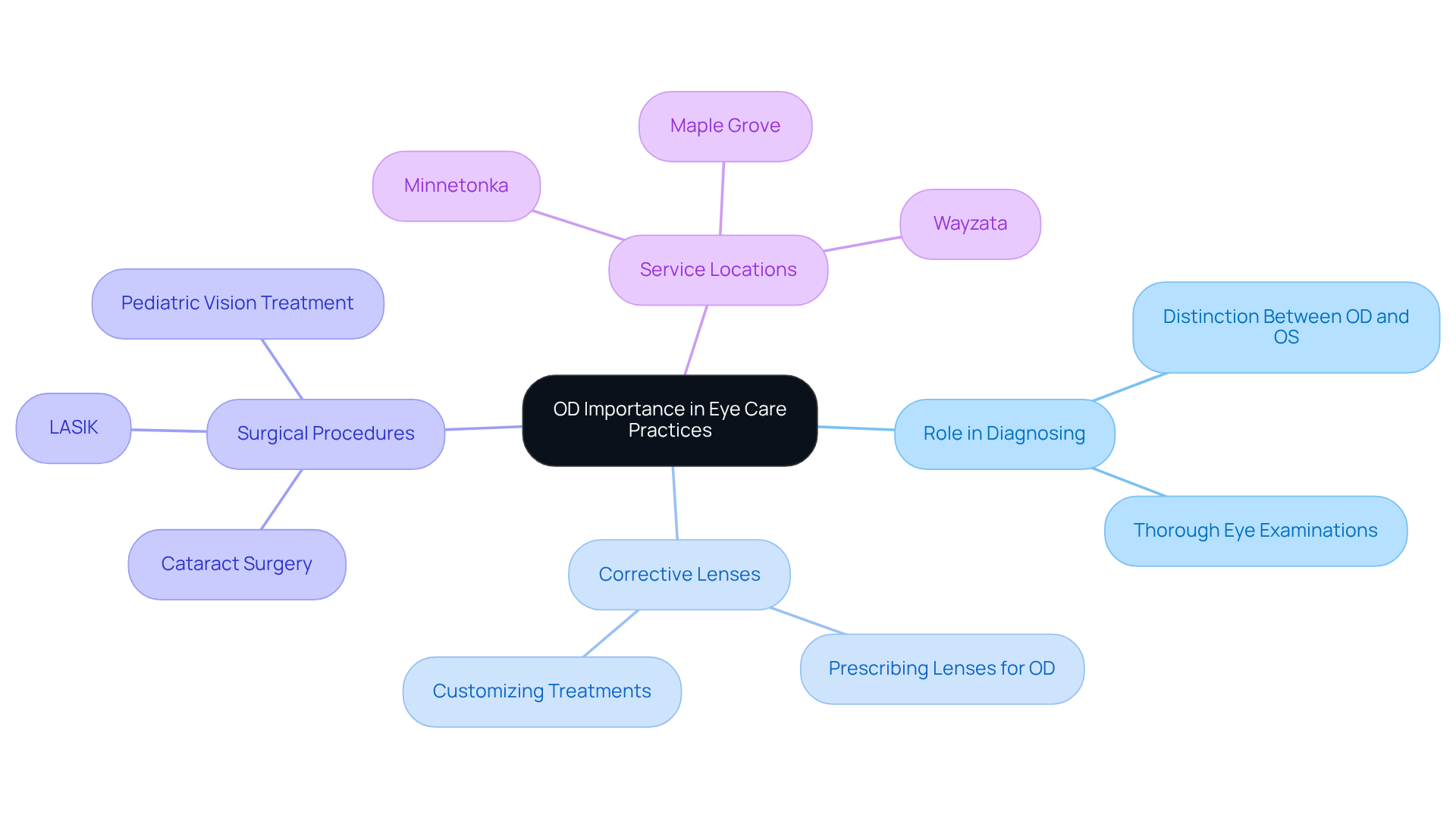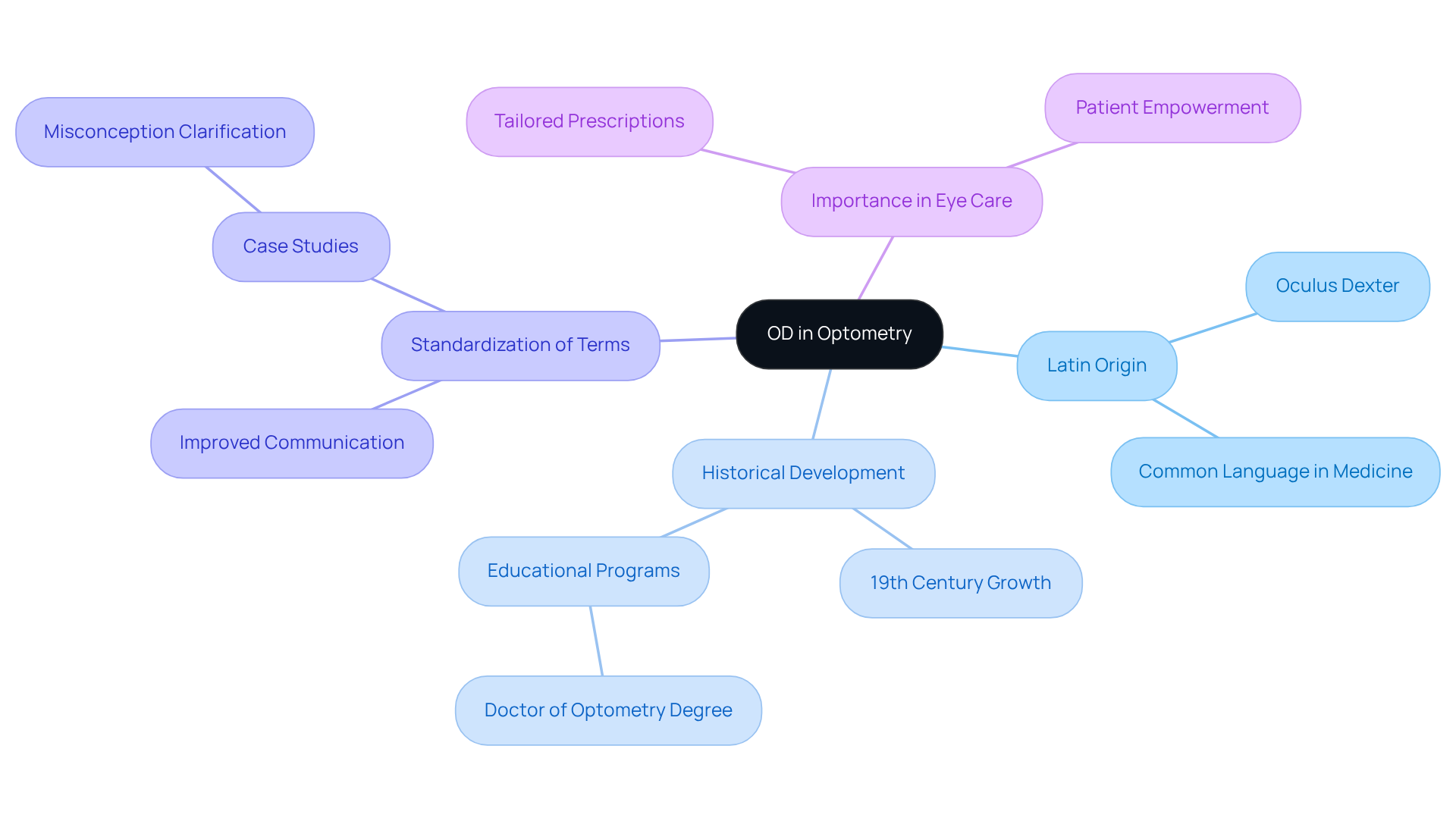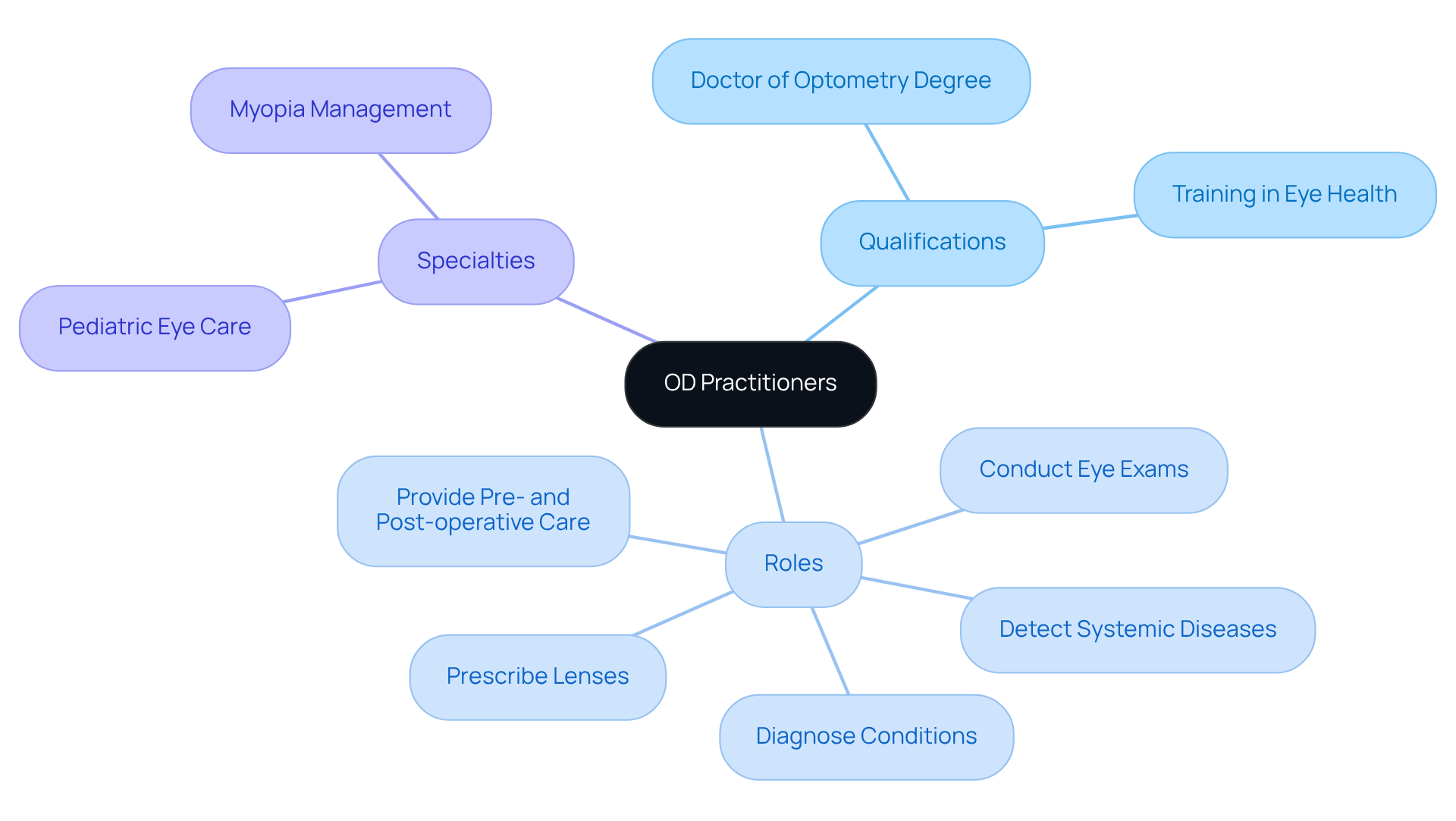Posted by: Northwest Eye in General on November 6, 2025
Overview
In eye care, the abbreviation OD stands for ‘Oculus Dexter,’ which means the right eye. Understanding this term is essential for accurately documenting prescriptions and treatment plans. We know that navigating medical terminology can feel overwhelming, but grasping these details can significantly enhance your engagement in your eye care journey.
It’s common to feel uncertain about what these terms mean, but knowing that OD refers to your right eye helps ensure that your visual needs are met with tailored solutions. This understanding not only empowers you but also reinforces the importance of clear communication between you and your eye care provider.
We are here to help you through this process, ensuring that you feel supported every step of the way. Remember, your eye health is a priority, and understanding these terms is just one part of your journey towards better vision.
Introduction
Navigating the world of eye care can sometimes feel overwhelming, especially with all the specialized terminology. One term that often comes up is the OD medical abbreviation, which stands for ‘Oculus Dexter’—the Latin phrase for the right eye. Understanding this abbreviation is crucial for making sense of prescriptions and treatment plans.
We understand that grasping these terms can be challenging, but knowing what they mean can significantly improve communication between you and your eye care professional. It empowers you to take charge of your vision health.
But what happens when these terms remain unclear? Exploring the meaning behind the OD abbreviation highlights the important connection between precise language and effective eye care practices. We’re here to help you through this process, ensuring you feel informed and supported every step of the way.
Define OD: The Meaning Behind the Abbreviation in Eye Care
The term ‘OD medical abbreviation eye,’ originating from the Latin phrase ‘Oculus Dexter,’ refers to the eye on the right side in eye care. This OD medical abbreviation eye plays a vital role in prescriptions and medical documentation, as it helps to specify the measurements and conditions relevant to the correct eye. We understand that navigating eye care can feel overwhelming, but grasping the meaning of the OD medical abbreviation eye is essential for both patients and practitioners. It allows for accurate interpretation of eye prescriptions and the development of effective treatment plans.
For example, a prescription might indicate that the right eye requires a specific lens power, such as -2.00 SPH. This detail directly impacts the corrective measures that will be implemented. It’s common to feel uncertain about these terms, but rest assured, understanding them can empower you in your treatment journey. Statistics reveal that visual acuity can vary significantly between the right and left eyes, which often necessitates distinct prescriptions for optimal vision correction.
Many individuals discover that their OD and OS (the left eye) values differ, highlighting the importance of personalized solutions in eye treatment. By comprehending the implications of the OD medical abbreviation eye, you can engage more actively in your treatment process. This understanding ensures you receive the appropriate corrective lenses tailored to your unique visual needs. Remember, we are here to help you through this process, providing the support you need every step of the way.

Contextualize OD: Importance in Eye Care Practices
In eye health practices, the OD medical abbreviation eye represents more than just a term; it’s vital for diagnosing and treating various eye conditions. We understand that navigating eye health can feel overwhelming, and at Northwest Eye, our optometrists and ophthalmologists are here to support you every step of the way.
When we refer to the OD medical abbreviation eye, we’re distinguishing between the dominant eye and the left eye, which we call OS, or ‘Oculus Sinister.’ This distinction is crucial during thorough eye examinations, when prescribing corrective lenses, or planning surgical procedures like cataract surgery, LASIK, and pediatric vision treatment. We know that precise measurements for each eye are essential, and using the OD medical abbreviation eye helps us ensure that the specifications for your right eye are accurately recorded and addressed.
By incorporating this practice into our patient-focused approach, we enhance the quality of service we provide. Our goal is to customize treatments that meet the unique needs of our patients across different locations, including:
- Minnetonka
- Maple Grove
- Wayzata
We are here to help you through this process, ensuring you feel informed and cared for.

Trace the Origins of OD: Historical Background and Development
The OD medical abbreviation eye comes from the Latin term ‘Oculus Dexter,’ which means ‘right eye.’ This connection to Latin highlights a long-standing tradition in medical terminology, where Latin has served as a common language among scholars and practitioners for centuries. As optometry developed into its own field in the late 19th and early 20th centuries, the OD medical abbreviation eye became standard practice.
We understand that navigating medical terminology can feel overwhelming. However, this historical context underscores the importance of clear and accurate language in medical documentation and communication, especially in today’s eye care. The formal recognition of optometry as a profession, along with the creation of educational programs leading to the Doctor of Optometry (OD) degree, has solidified the use of the OD medical abbreviation eye in clinical settings.
It’s common to feel uncertain about what these terms mean. Case studies show that standardizing terms, such as the OD medical abbreviation eye, has improved communication among eye care professionals, ensuring that prescriptions are tailored to meet individual needs. This level of accuracy is vital for achieving the best possible vision results.
We are here to help you understand these terms and their significance in your eye health journey. Knowing what OD means can empower you to engage more confidently with your eye care provider.

Identify Key Characteristics: Qualifications and Roles of OD Practitioners
Optometrists, often associated with the OD medical abbreviation eye, are dedicated healthcare professionals who have earned a Doctor of Optometry degree. This extensive training equips them with the knowledge needed in eye health, vision science, and client support. They are qualified to conduct thorough eye exams, diagnose and manage various eye conditions, and prescribe corrective lenses.
We understand that facing vision issues can be concerning. OD practitioners often serve as the first point of contact for individuals seeking help, playing a vital role in basic eye treatment. Moreover, they are trained to detect systemic diseases that may show symptoms in the eyes, highlighting their importance in overall patient health.
Their expertise extends to fitting contact lenses and providing pre- and post-operative care for eye surgeries, further emphasizing their significance in the continuum of eye treatment. At Northwest Eye, Dr. Nicole N. Sheffer, known for her O.D. medical abbreviation eye, exemplifies this commitment to care. She specializes in comprehensive eye care, pediatric eye care, and myopia management across several locations, including Wayzata, St. Anthony, Golden Valley, and Maple Grove.
This patient-centered approach ensures that you receive tailored solutions for your eye health needs. We are here to help you through this process, providing the support and expertise you deserve.

Conclusion
Understanding the OD medical abbreviation is essential for anyone navigating the world of eye care. This term, derived from the Latin “Oculus Dexter,” signifies the right eye and serves as a foundational element in prescriptions and medical documentation. We understand that comprehending this abbreviation can feel overwhelming, but it’s a crucial step in taking charge of your eye health. By grasping its meaning, you empower yourself to engage more effectively with your healthcare providers.
Throughout this article, we’ve shared key insights about the significance of the OD abbreviation in eye care practices. It plays a vital role in diagnosing and treating various conditions, ensuring that each patient’s unique needs are addressed. The historical context of the term highlights its evolution and importance in standardizing communication among eye care professionals. Furthermore, the qualifications and roles of OD practitioners underscore their commitment to delivering personalized care, which is essential for effective treatment outcomes.
It’s common to feel uncertain about medical jargon, but recognizing the meaning and implications of the OD medical abbreviation is an important step in advocating for your eye health. As you become more informed about these terms, you can make educated decisions regarding your vision care. Engaging with eye care professionals and understanding the language of eye health ultimately leads to better outcomes and an enhanced quality of life.
We are here to help you through this process, ensuring you feel supported every step of the way.
Frequently Asked Questions
What does the abbreviation OD stand for in eye care?
The abbreviation OD stands for ‘Oculus Dexter,’ which is Latin for the right eye.
Why is the OD abbreviation important in eye care?
The OD abbreviation is vital for prescriptions and medical documentation as it specifies measurements and conditions relevant to the right eye, ensuring accurate interpretation and effective treatment plans.
How can understanding the OD abbreviation benefit patients?
Understanding the OD abbreviation empowers patients to engage actively in their treatment process, ensuring they receive appropriate corrective lenses tailored to their unique visual needs.
What might a prescription with OD indicate?
A prescription with OD might indicate specific lens power for the right eye, such as -2.00 SPH, which directly impacts the corrective measures to be implemented.
How do OD values compare to OS values?
Many individuals find that their OD (right eye) and OS (left eye) values differ, highlighting the need for personalized solutions in eye treatment to achieve optimal vision correction.
What role do statistics play in understanding visual acuity between the eyes?
Statistics show that visual acuity can vary significantly between the right and left eyes, often necessitating distinct prescriptions for each eye to ensure proper vision correction.






